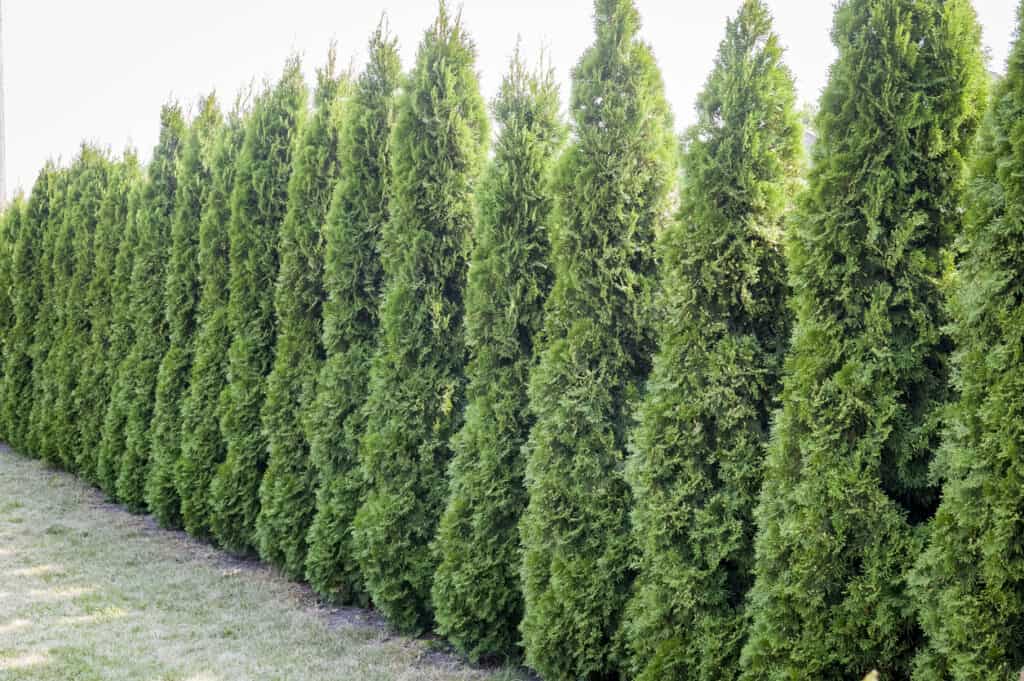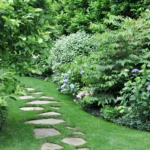
12 Fast-Growing Privacy Bushes for a Low-Maintenance Garden
Posted in :
The thought of someone yelling, “Hi neighbor, what’s up?” is probably the last thing on your mind when you’re trying to enjoy a quiet suntan. Or share a romantic dinner. Or casually dig in your backyard in the middle of the night.
So, who you gonna call? Fast Growing Bushes. They’re the silent guardians of your space. No talking, no peeking, and absolutely no judgment on those delivery piles.
1) Arborvitae (‘Green Giant’)

The aptly named evergreen lives up to its title when planted in rows. It grows remarkably tall, rapidly.
Its dense, upright form makes it a role-model for all who strive to stand in a living wall when they grow up. The ‘Green Giant’ variety is hardy, dependable, and relatively low maintenance year-round.
- Native alternative: Eastern Red Cedar (Juniperus virginiana)
- Arborvitae is non-invasive
2) Privet Hedge

Privet is your photogenic friend looking great both in Boho and black tie attire. Trim it to perfection or leave it bushy and layered, the choice is yours. It grows fast enough to change its outfit in pace with your whims.
- Native alternative: American Hazelnut (Corylus americana)
3) Forsythia

If there was ever an impatient bush, that’s Forsythia for you. It blossoms first, puts out leaves later. It’s a fast grower, although seasonal.
Precocious it may be, but it also leaves its leaves behind in the late fall. Yet, you’d forgive anything to those bright yellow blooms heralding spring.
- Native alternative: Witch Hazel (Hamamelis virginiana)
4) Holly (Inkberry or American)

Unlike some seasonal options (looking at Forsythia), Holly provides year-round seclusion. Both Inkberry and American varieties make a dense and truly effective evergreen privacy screen. As a bonus, Holly is rated 13/10 bird-friendly; besides shelter, it sometimes offers berries for the feathered snackers.
- American Holly (Ilex opaca) is native
- Valuable to wildlife and not invasive
5) Lilac

Lilac is an icon! It smells like heaven, and even a color wears its name. Although its privacy is seasonal, it offers fine visual protection during warmer months. So choose taller varieties and plant them closely to maximize their screening effect. It is growing moderately fast and rewards your patience with a bunch of breathtaking flowers each spring. The eventual bare branches are a worthy trade-off.
- Native alternative: Chokecherry (Prunus virginiana)
6) Viburnum

Arrowwood, Koreanspice, and Leatherleaf are just a few of the many Viburnum kin, all celebrated for their notably dense foliage.
Thick and bushy, many Viburnums are alfa-shrubs with often fragrant white blooms. Excellent candidates for creating substantial outdoor privacy, these cousins are both pretty and effective yard guards.
- Native alternative: Arrowwood Viburnum (Viburnum dentatum)
7) Red Twig Dogwood

There’s more than meets the eye with Red Twig Dogwood, especially when winter comes. Leafy in summer, its bright red stems are what truly sets it apart from other seasonal privacy shrubs. It is hardy, adaptable, fast and furious…-ly red.
- Red-osier dogwood (Cornus sericea) is native and not invasive.
8) Spirea

Don’t underestimate the privacy potential of Spirea. Yes, it is mostly celebrated for its generous seasonal flowers, available in a wide range of colors and sizes.
Still, many varieties also have a habit of compact and full growth. It provides a surprisingly effective visual barrier during the growing season and is easy to maintain.
- Native alternative: Meadowsweet (Spiraea alba or Spiraea tomentosa)
9) Butterfly Bush

Butterfly Bush is not always the first plant that comes to mind for dense privacy. It usually does offer substantial growth and provide an effective green screen.
Yet, it is more famous for being a LVL 100 pollinator magnet. What a row of Butterfly Bushes lacks in a somewhat see-through privacy department, it makes up for by creating buzz.
- Native alternative: Buttonbush (Cephalanthus occidentalis) or Summersweet (Clethra alnifolia)
10) Mock Orange (Philadelphus)

Someone must have been jealous of Philadelphus and called it Mock Orange. After all, it is elegant, easy to grow, and has white, stunningly fragrant and sweet flowers. So what if they resemble orange blossoms? And are also citrus-scented. Whoever enjoyed its sensory richness and leafy barrier never mocked it again.
- Native alternative: Virginia Sweetspire (Itea virginica)
11) Pittosporum

Someone sometime noticed that Pittosporum has soft white timber and thought to call it Cheesewood. It stuck. No matter how hard it tried to refute that reputation with dense, low-maintenance, well-behaved growth and an attractive and effective evergreen screen.
Many of its varieties even offer appealing foliage in shades of green, silver, or even burgundy! No luck. At least it smells really gouda, that’s a relief.
- Native alternative: Coastal Leucothoe (Leucothoe axillaris)
12) Texas Sage (Silverleaf)

Howdy, y’all lookin’ for a privacy shrub that can take on the sun without so much as a whimper. Silverleaf is tougher than a two-dollar steak in July, loves the heat, and ain’t too picky about waterin’.
Its leaves got this real purdy, silvery-gray sheen to ’em. Plant a few of these fellas side-by-side, and they’ll grow up nice and bushy, givin’ you a decent, if a bit airy, screen from pryin’ eyes.
- Native to Texas and Southwest U.S.
- Beautiful and not invasive
Where to Plant a Privacy Bush for Maximum Privacy?

Planting right along your property lines is a smart move for instant privacy. Then, create even more secluded outdoor living areas around patios, porches, or balconies.
While you’re at it, use staggered planting for a denser, more organic barrier. Try to combine evergreens with flowering shrubs for year-round coverage and seasonal beauty. And don’t forget to give roots room to grow and leaves a little air, too. Happy shrub, happy hub!

